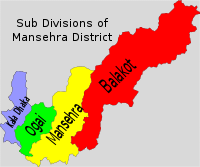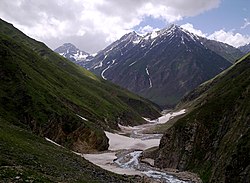Mansehra District
Mansehra District
ضلع مانسہرہ مانسهره ولسوالۍ | |
|---|---|
 Mansehra District (red) in Khyber Pakhtunkhwa | |
| Country | |
| Province | |
| Division | Hazara |
| Region | Pakhli |
| Headquarters | Mansehra |
| Government | |
| • Type | District Administration |
| • Deputy Commissioner | Bilal Shahid Rao (BPS-18 PAS) |
| • District Police Officer | Zahoor Babar Afridi (BPS-19 PSP) |
| Area | |
| • Total | 4,579 km2 (1,768 sq mi) |
| Population | |
| • Total | 1,797,177 |
| • Density | 390/km2 (1,000/sq mi) |
| Time zone | UTC+5 (PST) |
| Area code | 0997 |
| Number of union councils | 59 |
| Number of Tehsils | 5[2] |
| Website | mansehra |
Mansehra District (Urdu, Hindko: ضلع مانسہرہ) is a district in the Hazara Division, Khyber Pakhtunkhwa, northern Pakistan. Mansehra city serves as the headquarters of the district.
Mansehra was established as an independent district in 1976. It was previously a tehsil within the broader Hazara District.[3] In 1993, a former subdivision of Mansehra, Battagram, was separated as an independent district.[4] Similarly, in 2011, another subdivision of Mansehra, Kala Dhaka, was separated which is now known as Torghar District.
Demographics
[edit]| Year | Pop. | ±% p.a. |
|---|---|---|
| 1951 | 260,631 | — |
| 1961 | 373,975 | +3.68% |
| 1972 | 552,842 | +3.62% |
| 1981 | 686,308 | +2.43% |
| 1998 | 978,157 | +2.11% |
| 2017 | 1,555,742 | +2.47% |
| 2023 | 1,797,177 | +2.43% |
| Sources:[5] | ||
As of the 2023 census, Mansehra district has 294,052 households and a population of 1,797,177. The district has a sex ratio of 103.08 males to 100 females and a literacy rate of 63.79%: 75.33% for males and 52.02% for females. 478,985 (26.76% of the surveyed population) are under 10 years of age. 154,834 (8.62%) live in urban areas.[1]
| Religion | 1941[6]: 22 [a] | 2017[7] | 2023[8] | |||
|---|---|---|---|---|---|---|
| Pop. | % | Pop. | % | Pop. | % | |
| Islam |
293,231 | 97.79% | 1,555,315 | 99.97% | 1,785,071 | 99.75% |
| Hinduism |
5,431 | 1.81% | 28 | ~0% | 39 | ~0% |
| Sikhism |
1,174 | 0.39% | — | — | 31 | ~0% |
| Christianity |
22 | 0.01% | 163 | 0.01% | 3,986 | 0.22% |
| Other | 0 | ~0% | 236 | 0.02% | 497 | 0.03% |
| Total Population | 299,858 | 100% | 1,555,742 | 100% | 1,789,624[b] | 100% |
At the time of the 2023 census, 66.22% of the population spoke Hindko, 17.97% Pashto, 2.51% Kohistani and 1.16% Urdu as their first language.[9]
Many of these, especially in the upper Kaghan Valley, are speakers of the Kohistani dialects. There are also speakers of the widely dispersed Gujari language, particularly in the Kaghan Valley.[10] The local variety is intermediate between the eastern dialects of Gujari (spoken in Azad Kashmir) and the western group (from Chitral, Swat and Gilgit).[11] There is also a small community in the village of Dana in Oghi Tehsil who speak the endangered Mankiyali language.[12] Many people can write and speak English.[citation needed]
Constituencies
[edit]The district is represented in the Khyber Pakhtunkhwa Assembly by elected MPAs who represent the following constituencies:[13]
Constituency and current member :
- PK-36 (Mansehra-I), Munir Lughmani Swati
- PK-37 (Manshera-II), Babar Saleem Swati
- PK 38 (Mansehra III), Zahid Chanzeb Swati
- PK 39 (Mansehra IV), Ikram Ghazi Tanoli
- PK 40 (Mansehra V), Sardar Shah Jahan
The district is represented in the National Assembly of Pakistan by two elected MNAs who represent the following constituencies:
Administrative divisions
[edit]
Mansehra District consists of six tehsils, with Tanawal Tehsil separated from the other five in December 2022.[14]
- Balakot (Urdu: تحصیل بالاکوٹ; Pashto: بالاکوټ تحصیل)
- Mansehra (Urdu: تحصیل مانسہرہ; Pashto: مانسهره تحصیل)
- Oghi (Urdu: تحصیل اوگی; Pashto: اوګي تحصیل)
- Baffa Pakhal (Urdu: تحصیل بفہ پکھل; Pashto: بفه پکلي تحصیل)[15]
- Darband (Urdu: تحصیل دربند; Pashto: دربند تحصیل)[16]
- Tanawal
The Kala Dhaka tehsil was separated as Torghar District in 2011.
Provincial Assembly
[edit]| Member of Provincial Assembly | Party Affiliation | Constituency | Year |
|---|---|---|---|
| Munir Lughmani Swati | Pakistan Tehreek-e-Insaf | PK-36 Mansehra-I | 2024 |
| Babar Saleem Khan Swati | Pakistan Tehreek-e-Insaf | PK-37 Mansehra-II | 2024 |
| Zahid Chanzeb Swati | Pakistan Tehreek-e-Insaf | PK-38 Mansehra-III | 2024 |
| Ikram Ghazi Khan Tanoli | Pakistan Tehreek-e-Insaf | PK-39 Mansehra-IV | 2024 |
| Sardar Shah Jahan Yousaf | Pakistan Muslim League (N) | PK-40 Mansehra-V | 2024 |
Notable people
[edit]See also
[edit]References
[edit]- ^ a b "7th Population and Housing Census - Detailed Results: Table 1" (PDF). www.pbscensus.gov.pk. Pakistan Bureau of Statistics.
- ^ "Kolai-Palas made district, Baffa-Pakhal tehsil". 26 August 2017.
- ^ Census report of Mansehra 1998, p. 1.
- ^ Census report of Batagram 1998, p. 18.
- ^ "Population by administrative units 1951-1998" (PDF). Pakistan Bureau of Statistics.
- ^ "Census of India, 1941. Vol. 10, North-West Frontier Province". 1941. p. 22. JSTOR saoa.crl.28215543. Retrieved 23 September 2021.
- ^ "Pakistan Census 2017 District-Wise Tables: Mansehra District". Pakistan Bureau of Statistics.
- ^ "7th Population and Housing Census - Detailed Results: Table 9" (PDF). www.pbscensus.gov.pk. Pakistan Bureau of Statistics.
- ^ a b "7th Population and Housing Census - Detailed Results: Table 11" (PDF). Pakistan Bureau of Statistics.
- ^ Hallberg & O'Leary 1992, p. 96.
- ^ Hallberg & O'Leary 1992, pp. 112–13, 135The particular variety studied was from the village of Mittikot, six kilometres west of Balakot.
- ^ Anjum & Rehman 2015.
- ^ › reports
- ^ "Tanawal notified as sixth tehsil of Mansehra". Dawn. 26 December 2022. Retrieved 31 December 2022.
- ^ "Kolai-Palas made district, Baffa-Pakhal tehsil". 26 August 2017.
- ^ "Kolai-Palas made district, Baffa-Pakhal tehsil". 26 August 2017.
Bibliography
[edit]- 1998 District census report of Batagram. Census publication. Vol. 18. Islamabad: Population Census Organization, Statistics Division, Government of Pakistan. 1999.
- 1981 District census report of Mansehra. District Census Report. Vol. 23. Islamabad: Population Census Organization, Statistics Division, Government of Pakistan. 1983.
- 1998 District census report of Mansehra. Census publication. Vol. 62. Islamabad: Population Census Organization, Statistics Division, Government of Pakistan. 2000.
- Anjum, Uzma; Rehman, Khawaja (2015). "A First Look at Mankiyali Language: An Endangered Language". Journal of Asian Civilizations. 38 (1): 177–90. ProQuest 1816873650.
- Hallberg, Calinda E.; O'Leary, Clare F. (1992). "Dialect Variation and Multilingualism among Gujars of Pakistan". In O'Leary, Clare F.; Rensch, Calvin R.; Hallberg, Calinda E. (eds.). Hindko and Gujari. Sociolinguistic Survey of Northern Pakistan. Islamabad: National Institute of Pakistan Studies, Quaid-i-Azam University and Summer Institute of Linguistics. pp. 91–196. ISBN 969-8023-13-5.



